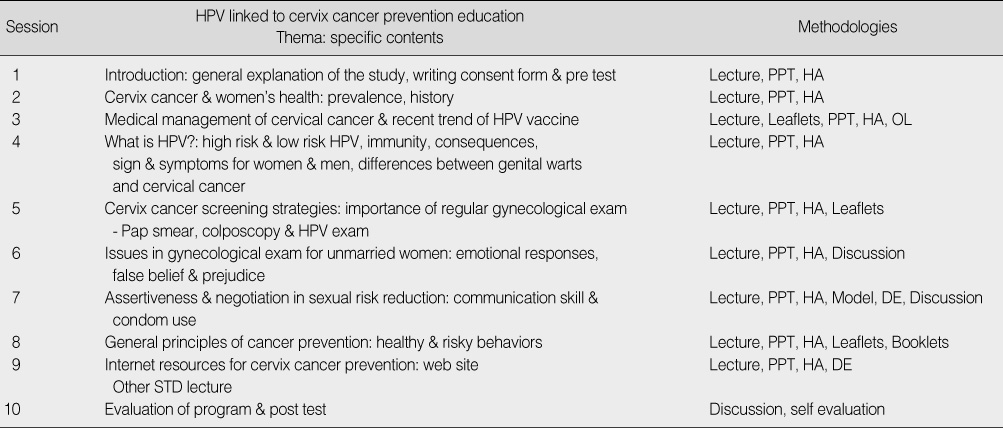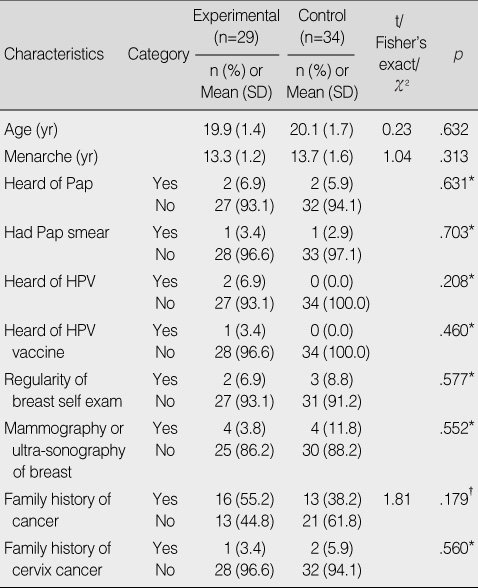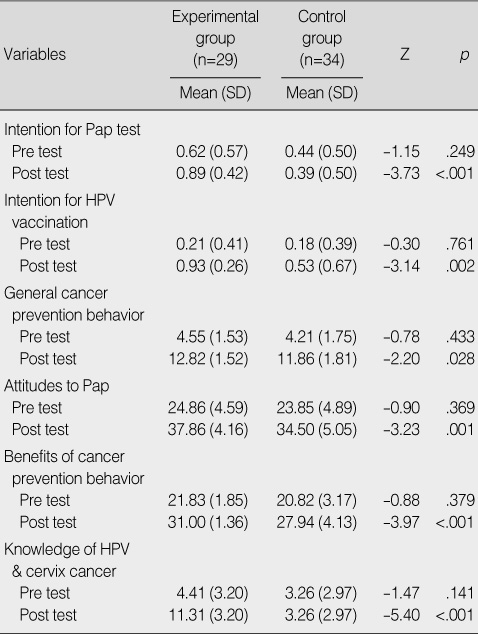Articles
- Page Path
- HOME > J Korean Acad Nurs > Volume 39(4); 2009 > Article
-
Original Article
- Effects of Prevention Education on Human Papillomavirus linked to Cervix Cancer for Unmarried Female University Students
- Hae Won Kim
-
Journal of Korean Academy of Nursing 2009;39(4):490-498.
DOI: https://doi.org/10.4040/jkan.2009.39.4.490
Published online: August 31, 2009
Professor, Department of Nursing, Kwandong University, Gangneung, Korea.
- Address reprint requests to: Kim, Hae Won. Department of Nursing, College of Medicine, Kwandong University, 522 Naegok-dong, Gangneung 210-701, Korea. Tel: 82-33-649-7613, Fax: 82-33-649-7620, hwkim@kd.ac.kr
Copyright © 2009 Korean Society of Nursing Science
Abstract
-
Purpose
- This study was done to identify the effects of a Human Papillomavirus (HPV) linked to cervix cancer prevention education program for unmarried university female students. A new model in the cervix cancer prevention is provided.
-
Methods
- The research design was a nonequivalent control group pretest-posttest design. Participants were 63 female students in one of two university in an experimental group (29 students) and control group (34 students). After 4 weeks education, the differences between the two groups in the measurement variables were compared. Twelve weeks later, a follow-up test was done for experimental group only.
-
Results
- After the education, experimental group showed significantly higher scores in all variables, the intention for Pap test (Z=-3.73, p<.001), intention for HPV vaccination (Z=-3.14, p=.002), general cancer prevention behavior (Z=-2.20, p=.028), attitudes to Pap (Z=-3.23, p=.001), benefits of cancer prevention behavior (Z=-3.97, p<.001), and HPV linked to cervix cancer knowledge (Z=-5.40, p<.001). In the follow-up study, the experimental group showed intermediate effects in intention for Pap test, intention of HPV vaccination and HPV linked to cervix cancer knowledge as well as short term effects in general cancer prevention behavior, attitudes to Pap and benefits of cancer prevention behavior.
-
Conclusion
- The program developed for this study on prevention education of HPV linked to cervix cancer was effective for unmarried university students in the short term and intermediate duration. Other educational approaches should be developed and short term effects and longitudinal changes of the education should be assessed. This education program should also be replicated for other female groups including unmarried working women or female adolescents.
This work was supported by the Korea Research Foundation Grant funded by the Korean Government (MOEHRD) (KRF-2008-531-E00089).
- 1. Armstrong LL. Predicting cervical screening in college women: A test of the theory of reasoned action. 2001;Missoula, USA, University of Montana. Unpublished doctoral dissertation.
- 2. Choe SA. Factors influencing continuous Pap smear participation in women employed in a general hospital. 2002;Seoul, Yonsei University. Unpublished master's thesis.
- 3. Choi KA, Kim JH, Lee KS, Oh JK, Liu SN, Shin HR. Knowledge of human papillomavirus infection and acceptability of vaccination among adult women in Korea. Korean Journal of Obstetrics and Gynecology. 2008;51:617–623.
- 4. Cohen J. Statistical power analysis for the behavioral sciences. 1988;2nd ed. Mahwah, Lawrence Erlbaum Associates.
- 5. Fernandez-Esquer ME, Ross MW. The importance of psychosocial factors in the prevention of HPV infection and cervical cancer. International Journal of STD & AIDS. 2000;11:701–713.ArticlePDF
- 6. Fletcher PC, Bryden PJ. Preliminary examination of cervical health practices and knowledge among university aged females. College Student Journal. 2005;39:469–477.
- 7. Ingledue K, Cotrrell R, Bernard A. College women's knowledge, perceptions, and preventive behaviors regarding Human Papillomavirus infection and cervical cancer. American Journal of Health Studies. 2004;19:28–34.
- 8. Ji SW. A study on the knowledge of Human Papillomavirus and cervical cancer in nurses. 2009;Gangneung, Kwandong University. Unpublished master's thesis.
- 9. Jo SJ. Development and evaluation of community based program for promotion of cervical cancer screening via internet. 2003;Seoul, The Catholic University of Korea. Unpublished doctoral dissertation.
- 10. Joo WD, Kim SH, Kim DY, Suh DS, Kim JH, Kim YM, et al. Prevalence of Human papillomavirus infection in Korean women: Risk of abnormal Pap smear and cervical neoplasia. Korean Journal of Gynecology Oncology Colposcopy. 2004;15:309–316.
- 11. Kim HW, Ahn HY. Study on the knowledge of Human papillomavirus in female university students. Korean Journal of Women Health Nursing. 2007;13:13–20.ArticlePDF
- 12. Kim JU. Relationship between middle aged women's cognitive perceptual factors and examination for detection of cancer. 2006;Incheon, Gachon Medical University. Unpublished master's thesis.
- 13. Kim M. The effect of nursing intervention on the rescreening compliance of cervical cancer screening clients. 2005;Gwangju, Chonman National University. Unpublished doctoral dissertation.
- 14. Kim SH. Study on the characteristics and related factors of female cancer's screening and repeat screening. 2004;Busan, Pusan National University. Unpublished master's thesis.
- 15. Marlow LA, Waller J, Wardle J. Public awareness that HPV is a risk factor for cervical cancer. British Journal of Cancer. 2007;97:691–694.ArticlePubMedPMCPDF
- 16. Annual report of cancer incidence (2005) and survival (1993-2005) in Korea. Ministry of Health, Welfare and Family Affairs. 2008;10 30 Retrieved from January 10, 2009. from http://www.w3.org/1999/xlink" xlink:href="http://stat.mw.go.kr/homepage/data/part_data_content.jsp?menu_id=21&curr_page=1&board_bcd=2&ctrl_command=doNothing&seq_no=10312.
- 17. Early examination of cervical cancer. National Cancer Information Center. 2009;01 23 Retrieved July 9, 2009. from http://211.114.9.232/nciapps/user/basicinfo/each_cancer_main.jsp.
- 18. Park SM, Chang SB, Chung JW. Content analysis on cognitive affective experience in Pap smear participants. Journal of Korean Society of Maternal Child Health. 2004;8:37–48.
- 19. Risi L, Bindman JP, Campbell OM, Imrie J, Everett K, Bradely J, et al. Media interventions to increase cervical screening uptake in South Africa: An evaluation study of effectiveness. Health Education Research Theory & Practice. 2004;19:457–468.
- 20. Sabate R, Feinstein L. The role of education in the uptake of preventive health care: The case of cervical screening in Britain. Social Science & Medicine. 2006;62:2998–3010.Article
- 21. Shin HR, Franceschi S, Vaccarella S, Roh JW, Ju YH, Oh JK, et al. Prevalence and determinants of genital infection with papilloma virus, in female and male university students in Busan, South Korea. Journal of Infectious Disease. 2004;190:468–476.Article
REFERENCES
Figure & Data
REFERENCES
- 1. Armstrong LL. Predicting cervical screening in college women: A test of the theory of reasoned action. 2001;Missoula, USA, University of Montana. Unpublished doctoral dissertation.
- 2. Choe SA. Factors influencing continuous Pap smear participation in women employed in a general hospital. 2002;Seoul, Yonsei University. Unpublished master's thesis.
- 3. Choi KA, Kim JH, Lee KS, Oh JK, Liu SN, Shin HR. Knowledge of human papillomavirus infection and acceptability of vaccination among adult women in Korea. Korean Journal of Obstetrics and Gynecology. 2008;51:617–623.
- 4. Cohen J. Statistical power analysis for the behavioral sciences. 1988;2nd ed. Mahwah, Lawrence Erlbaum Associates.
- 5. Fernandez-Esquer ME, Ross MW. The importance of psychosocial factors in the prevention of HPV infection and cervical cancer. International Journal of STD & AIDS. 2000;11:701–713.ArticlePDF
- 6. Fletcher PC, Bryden PJ. Preliminary examination of cervical health practices and knowledge among university aged females. College Student Journal. 2005;39:469–477.
- 7. Ingledue K, Cotrrell R, Bernard A. College women's knowledge, perceptions, and preventive behaviors regarding Human Papillomavirus infection and cervical cancer. American Journal of Health Studies. 2004;19:28–34.
- 8. Ji SW. A study on the knowledge of Human Papillomavirus and cervical cancer in nurses. 2009;Gangneung, Kwandong University. Unpublished master's thesis.
- 9. Jo SJ. Development and evaluation of community based program for promotion of cervical cancer screening via internet. 2003;Seoul, The Catholic University of Korea. Unpublished doctoral dissertation.
- 10. Joo WD, Kim SH, Kim DY, Suh DS, Kim JH, Kim YM, et al. Prevalence of Human papillomavirus infection in Korean women: Risk of abnormal Pap smear and cervical neoplasia. Korean Journal of Gynecology Oncology Colposcopy. 2004;15:309–316.
- 11. Kim HW, Ahn HY. Study on the knowledge of Human papillomavirus in female university students. Korean Journal of Women Health Nursing. 2007;13:13–20.ArticlePDF
- 12. Kim JU. Relationship between middle aged women's cognitive perceptual factors and examination for detection of cancer. 2006;Incheon, Gachon Medical University. Unpublished master's thesis.
- 13. Kim M. The effect of nursing intervention on the rescreening compliance of cervical cancer screening clients. 2005;Gwangju, Chonman National University. Unpublished doctoral dissertation.
- 14. Kim SH. Study on the characteristics and related factors of female cancer's screening and repeat screening. 2004;Busan, Pusan National University. Unpublished master's thesis.
- 15. Marlow LA, Waller J, Wardle J. Public awareness that HPV is a risk factor for cervical cancer. British Journal of Cancer. 2007;97:691–694.ArticlePubMedPMCPDF
- 16. Annual report of cancer incidence (2005) and survival (1993-2005) in Korea. Ministry of Health, Welfare and Family Affairs. 2008;10 30 Retrieved from January 10, 2009. from http://www.w3.org/1999/xlink" xlink:href="http://stat.mw.go.kr/homepage/data/part_data_content.jsp?menu_id=21&curr_page=1&board_bcd=2&ctrl_command=doNothing&seq_no=10312.
- 17. Early examination of cervical cancer. National Cancer Information Center. 2009;01 23 Retrieved July 9, 2009. from http://211.114.9.232/nciapps/user/basicinfo/each_cancer_main.jsp.
- 18. Park SM, Chang SB, Chung JW. Content analysis on cognitive affective experience in Pap smear participants. Journal of Korean Society of Maternal Child Health. 2004;8:37–48.
- 19. Risi L, Bindman JP, Campbell OM, Imrie J, Everett K, Bradely J, et al. Media interventions to increase cervical screening uptake in South Africa: An evaluation study of effectiveness. Health Education Research Theory & Practice. 2004;19:457–468.
- 20. Sabate R, Feinstein L. The role of education in the uptake of preventive health care: The case of cervical screening in Britain. Social Science & Medicine. 2006;62:2998–3010.Article
- 21. Shin HR, Franceschi S, Vaccarella S, Roh JW, Ju YH, Oh JK, et al. Prevalence and determinants of genital infection with papilloma virus, in female and male university students in Busan, South Korea. Journal of Infectious Disease. 2004;190:468–476.Article
Citations

- Effects of a Human Papilloma Virus (HPV) Prevention Education among Girls in 6th Grade Elementary School, South Korea
Jeon Hee Kim, Soonyoung Park, Youngmi Cho, Sohyune Sok
Sage Open.2023;[Epub] CrossRef - Ecological factors affecting first-time mothers’ satisfaction with Sanhujoriwons (postpartum care centres) from South Korea: a cross-sectional and correlational study
Ju-Eun Song, Soyeon Lee, Min Kyong Lee, Hyun-Ju Chae
BMC Pregnancy and Childbirth.2023;[Epub] CrossRef - Ecological factors influencing parenting self-efficacy among working mothers with a child under 36 month old in South Korea: a cross‐sectional and correlational study
Ju-Eun Song, Eun Ha Roh, Hyun-Ju Chae, Tiffany Kim
BMC Women's Health.2022;[Epub] CrossRef - Effects of cervical cancer prevention education in middle-school girls in Korea: A mixed-method study
Hae Won Kim, Young Jin Lee, Da Bit Lee, Eun Ju Lee
Heliyon.2019; 5(6): e01826. CrossRef - Factors Influencing Human Papillomavirus Vaccination Intention among Unvaccinated Nursing Students in Korea
Younghee Yun, Chin Kang Koh
Journal of Korean Academic Society of Nursing Education.2018; 24(3): 205. CrossRef - Barriers to Cervical Cancer Screening and Prevention in Young Korean Immigrant Women: Implications for Intervention Development
Hee Yun Lee, Mi Hwa Lee
Journal of Transcultural Nursing.2017; 28(4): 353. CrossRef - Factors Influencing Intention for Human Papillomavirus Vaccination Among Parents with Elementary School Girls
Jung lim Shim, Yun Ju Ha
Journal of Korean Academic Society of Nursing Education.2017; 23(4): 367. CrossRef - Factors affecting Human Papillomavirus Vaccination among College Nursing Students
Eun-Jeoung Kim, Su Hyun Kim, Hyang-In Cho Chung, Young A Kim
Journal of the Korea Academia-Industrial cooperation Society.2016; 17(3): 464. CrossRef - Predictors of HPV Vaccination Status in Female Nursing University Students: HPV related Knowledge and Perception
Hyunju Park
Journal of the Korean Society of School Health.2016; 29(3): 123. CrossRef - Development and Effects of Cancer Prevention Program for Nursing Students
Youn Na Lee, In Soo Kwon
Asian Oncology Nursing.2016; 16(4): 185. CrossRef - The effects of an HPV education program by gender among Korean university students
Hae Won Kim, Seungmi Park, Hye Young Ahn, Eun-Jun Park
Nurse Education Today.2015; 35(4): 562. CrossRef - Factors Influencing Human Papillomavirus Vaccination Adoption Stages Based on the Precaution Adoption Process Model
Eun Nam Lee, Sun Hyoung Bae, Eun Hui Choi, Hyun Ju Hwang, Young Ock Lee, Jeong Lim Cho
Asian Oncology Nursing.2015; 15(2): 89. CrossRef - Awareness of Pap testing and factors associated with intent to undergo Pap testing by level of sexual experience in unmarried university students in Korea: results from an online survey
Hae Won Kim
BMC Women's Health.2014;[Epub] CrossRef - Influencing Factors of Intention of Undergoing Pap Testing among Unmarried Nurses
Hae Won Kim
Korean Journal of Women Health Nursing.2014; 20(3): 225. CrossRef - Factors Influencing Practices of Health Behavior for Cancer Prevention in University Students
Youn Na Lee, In Soo Kwon
Asian Oncology Nursing.2014; 14(2): 109. CrossRef - Changes in perceived health status, physical symptoms, and sleep satisfaction of postpartum women over time
Ju‐Eun Song, Hyun Ju Chae, Chang Hee Kim
Nursing & Health Sciences.2014; 16(3): 335. CrossRef - Knowledge Level of Human Papillomavirus, Cervical Cancer and Vaccination Status among Mothers with Daughters in High School
Myung-Sook Yoo
Korean Journal of Women Health Nursing.2014; 20(1): 105. CrossRef - Evaluation of Korean Version of the Beliefs about Papanicolau Test and Cervical Cancer in Unmarried University Students
Hae Won Kim, Ga Yeon Ko
Korean Journal of Women Health Nursing.2013; 19(1): 13. CrossRef - Effects of a Peer Cervical Cancer Prevention Education Program on Korean Female College Students' Knowledge, Attitude, Self-efficacy, and Intention
Hyun Suk Mo, Keum Bong Choi, Jin Sun Kim
Korean Journal of Adult Nursing.2013; 25(6): 736. CrossRef - Effects of Human Papilloma Virus on related Education for Female High School Students
Jun-Young Choi, So-Young Choi
Asian Oncology Nursing.2013; 13(3): 128. CrossRef - Gender Differences in Knowledge and Health Beliefs Related to Behavioral Intentions to Prevent Human Papillomavirus Infection
Hae Won Kim
Asia Pacific Journal of Public Health.2013; 25(3): 248. CrossRef - Effect of an educational intervention on Hungarian adolescents’ awareness, beliefs and attitudes on the prevention of cervical cancer
Erika Marek, Timea Dergez, Gabor Rebek-Nagy, Istvan Szilard, Istvan Kiss, Istvan Ember, Peter Gocze, Gibson D’Cruz
Vaccine.2012; 30(48): 6824. CrossRef - Effects of Human Papillomavirus Vaccination Education on College Women's Knowledge, Health Belief, and Preventive Behavior Intention
Eun-Jee Lee, Hyeon-Ok Kim
Journal of Korean Academy of Nursing.2011; 41(5): 715. CrossRef - Comparison of Factors Associated with Intention to Receive Human Papillomavirus Vaccine Between Male and Female Undergraduate Students
Hae Won Kim
Korean Journal of Women Health Nursing.2011; 17(4): 415. CrossRef - Clinical Nurses' HPV-related Knowledge and Perception of Cancer Causes: HPV Vaccinated vs. Not Vaccinated
Mi Hyang Lee, Eun Jung Lim, Young Hee Yu, Myung Hee Jun
Korean Journal of Women Health Nursing.2011; 17(1): 1. CrossRef - Female University Students' HPV-related Knowledge and Influencing Factors on HPV Vaccination
Kyung-Sook Bang, Sumi Sung, Boyeon Koo, Minji Kim, Yuna Kim, Jinsook Kim, Sumi Ryu
Journal of Korean Oncology Nursing.2011; 11(3): 186. CrossRef - Knowledge, Attitudes of Human Papillomavirus Vaccine, and Intention to Obtain Vaccine Among Korean Female Undergraduate Students
Hee-Young Kang, Jin-Sun Kim
Women & Health.2011; 51(8): 759. CrossRef - Relating Factors in Pap Smears by Stages of Change among Married Nurses
Hae Won Kim, Yeon Yi Jung
Korean Journal of Women Health Nursing.2010; 16(4): 317. CrossRef
HPV linked to Cervix Cancer Prevention Education Program: Contents & Methodologies
HPV=human papillomavirus; STD=sexually transmitted disease; PPT=power point; HA=handout; OA=online lecture via internet; DE=demonstration.
Homogeneity Test for General Characteristics between Groups (N=63)
*Fisher's exact test; †χ2 test.
HPV=human papillomavirus.
Homogeneity Test and Educational Effects for Measurement Variables between Groups: Pre & Post Test (N=63)
HPV=human papillomavirus.
Changes of Measurement Variables in Experimental Group from Pre Test, Post Test, and 12 weeks Post Test
HPV=human papillomavirus.
HPV=human papillomavirus; STD=sexually transmitted disease; PPT=power point; HA=handout; OA=online lecture via internet; DE=demonstration.
*Fisher's exact test; †χ2 test.
HPV=human papillomavirus.
HPV=human papillomavirus.
HPV=human papillomavirus.
 KSNS
KSNS
 E-SUBMISSION
E-SUBMISSION




 Cite
Cite

